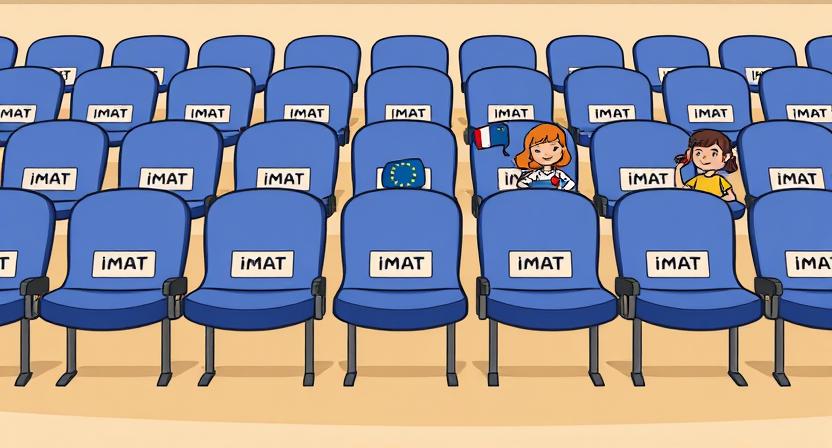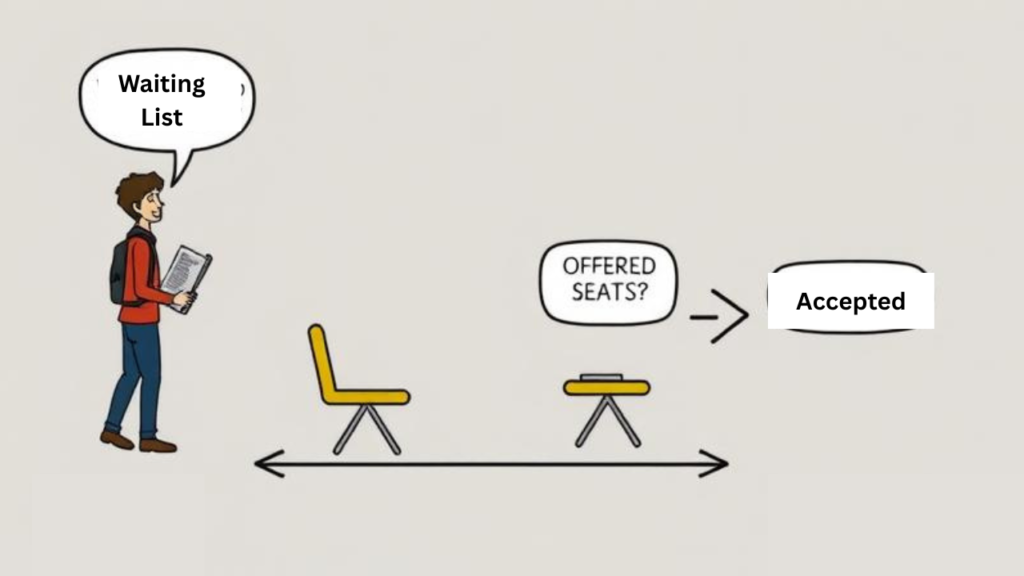
Table of Contents
If you dream of studying medicine in Italy, you have to take the IMAT exam. But getting a good score is just the beginning. After the exam, many students wonder, “How are IMAT seats allocated in Italy?”
The answer is simple, but also very important. In Italy, there are only certain seats for medical students. These spots are divided between students from the EU and students from outside the EU. You don’t just need a good score—you also need to know how the seats are given out.
In this blog, we will explain how IMAT seats allocation in Italy works, who gets the seats first, and how you can improve your chances. We will keep everything easy to understand, even if this is your first time learning about IMAT. Let’s get started!
What Is the IMAT Exam?
The IMAT stands for International Medical Admissions Test. It is a special exam made for students who want to study medicine or dentistry in English at public universities in Italy. This test checks how good you are at subjects like biology, chemistry, math, physics, and logic. It is not too long—just 60 questions—but it is very important. The better you score, the better your chances of getting a seat at your dream university.
The IMAT is held annually, and students from all over the world participate. The exam is in English, making it ideal for students who don’t speak Italian but want to study in Italy.
Why Students Take the IMAT
Many students opt for the IMAT because they want to study medicine in Italy in English. Italy has some very good medical universities that are also more affordable than those in the UK, the US, or other countries. The degrees are recognized across Europe and many other parts of the world.
Also, students like that they can study in a beautiful country like Italy while getting a high-quality education. Taking the IMAT is the first step toward making this dream a reality.
Universities That Use IMAT in Italy
Not all universities in Italy use the IMAT. Only a few public universities offer medical programs taught in English, and they use the IMAT to select students. Here are some of the most well-known ones:
- University of Milan
- University of Pavia
- University of Bologna
- University of Rome “La Sapienza”
- University of Turin
- University of Naples Federico II
- University of Padua
- University of Messina
Each of these universities offers a set number of IMAT spots for EU and non-EU students. That’s why it’s important to learn about IMAT seats allocation in Italy, so you know your chances at each university.
Understanding IMAT Seats Allocation in Italy
After taking the IMAT exam, the next big question is: how are IMAT seats allocated in Italy? To answer that, you need to understand a few basic things about the seats, how many there are, and who can apply for them.
What Are IMAT Seats?

IMAT seats are the limited spots available for students in English-taught medical programs in Italy. Each university has only a small number of these seats. That means not everyone who takes the IMAT will get in—only the students with the highest scores will win a seat.
Think of it like chairs in a classroom. If there are only 50 chairs but 500 students want to join, only the top 50 students who score the most will get to sit. That’s why IMAT seats allocation in Italy is all about ranking.
How Many Seats Are Available Each Year?
The number of IMAT seats can vary each year. The Italian government decides how many seats to give to each university based on its capacity and rules. On average:
- Some universities may have 60 to 100 seats in total.
- These spots are split between EU and non-EU students.
For example, a university might offer:
- 40 seats for EU students
- 20 seats for non-EU students
So if you are a non-EU student, you will compete only for those 20 seats. If you are from the EU, you will be competing for one of the 40 available seats. This is why knowing how many seats are offered each year is important. It helps you plan better and choose your university wisely.
Difference Between EU and Non-EU Seats

The seats are divided into two categories:
- EU Seats: These are for students who are from a country in the European Union or have the same rights as EU citizens.
- Non-EU Seats: These are reserved for students from countries outside the European Union.
🔹 EU students compete only with other EU students.
🔹 Non-EU students only compete against other non-EU students.
This means that an EU student can’t take a non-EU student’s seat, and vice versa. So, if you are from India, Pakistan, Nigeria, USA, or any non-EU country, you will only be ranked with other non-EU students.
Additionally, the number of non-EU seats is typically smaller, making the competition much tougher for non-EU students. That’s why understanding IMAT seats allocation in Italy is key to knowing how hard you need to work and what your chances really are.
How IMAT Seats Allocation in Italy Works
Now let’s look at how IMAT seats allocation in Italy really works. Once you take the IMAT exam, your score will determine your chances of being accepted. The higher your score, the better your chance of getting a seat in your dream university. Let’s go through it step by step.
Score Ranking and Seat Assignment
After everyone finishes the IMAT test, the scores are listed from highest to lowest. This is called the ranking list. Students at the top of the list get the first chance to pick a seat.
Each student’s score is checked, and universities give out seats one by one, starting from the highest-scoring student. If you have a high score, you get to choose first. If your score is lower, you’ll have to wait and see if seats are left.
This is why IMAT seats allocation in Italy depends so much on your ranking. The higher you score, the more likely you are to get accepted!
First Choice vs. Second Choice University
When you apply for IMAT, you choose two universities:
- One is your first choice
- The other is your second choice
If you get a high score, and seats are still open at your first choice, you will get a seat there. If the seats at your first-choice university are filled, you’ll be considered for your second choice instead.
So, it’s smart to think carefully about the order of your choices. Picking two universities gives you a better chance of getting a seat.
What Is the “Scorrimento” (Ranking Movement)?

“Scorrimento” is an Italian word that means “sliding” or “moving.” In the IMAT system, it means the ranking list moves when students give up their seats.
Here’s how it works:
- Some students say “yes” to a seat, but later they change their mind or go to a different university.
- When that happens, their seat becomes free.
- Then, the next person on the list gets offered that seat.
This process is called scorrimento. It keeps happening until all seats are full. So even if you didn’t get a seat right away, you still might get one later through ranking movement.
What if You Don’t Get Into Your First-Choice University?
If you don’t get into your top university choice, don’t stress—it’s not the end!. You’ll still have a chance to be considered for your other choices based on your IMAT score. There are still options:
- Check your second choice. If there are available seats at your second-choice university, you might be accepted based on your IMAT score.
- Wait for scorrimento. Sometimes, students leave their seats, and a spot opens for you.
- Be patient. The list keeps moving, and many students get in later, even weeks after results come out.
So if your dream school is full at first, you still have a chance! Just keep checking the ranking updates and don’t give up.
Special Rules for EU and Non-EU Students
When it comes to IMAT seats allocation in Italy, there are special rules based on where you are from. These rules are very important because the number of seats for EU and non-EU students is different. Let’s take a look at how this works for both groups.
Seats for EU Students

EU students are students who come from countries inside the European Union. They may also include students who:
- Have dual citizenship with an EU country
- Live in Italy with special rights
- Or are married to an EU citizen
These students have more seats available for them at each university. That means if you are an EU student, you will be competing only with other EU students, not with the whole world.
Example: If a university has 80 total seats, maybe 50 are for EU students and 30 are for non-EU.
So, the competition may still be tough, but you are in a separate group with more chances.
Seats for Non-EU Students
Non-EU students are from countries outside the European Union, such as:
- India
- Pakistan
- USA
- Canada
- Nigeria
- Philippines, and many more
These students have fewer seats available at each university. And they only compete with other non-EU students, not EU students.
So, even if your score is high, you need to make sure it’s high enough among non-EU students. In many cases, non-EU competition is very strong, because the number of seats is low and many students from around the world are applying.
This is why non-EU students need to understand how IMAT seats allocation in Italy works.
Can You Change Categories?
Sometimes students ask: “Can I change from non-EU to EU or the other way around?”
Here’s what you need to know:
- You cannot just choose your category. It depends on your passport, your residency, and your legal status in Italy.
- If you have an EU passport or meet special legal conditions, you may qualify as an EU student—even if you live outside Europe.
- You must tell the correct category during the application process. If you give the wrong information, your application may be rejected.
So, be careful and double-check your category before you apply. Changing categories later is not allowed in most cases.
Tips to Improve Your Chances of Getting a Better Seat in IMAT:
Getting a seat in an Italian medical university can be hard, especially with so much competition. But don’t worry! Here are some clever ways to improve your chances. Here are some simple tips to help you do well in the IMAT seats allocation in Italy.
Choose Your University Wisely
Not all universities are the same. Some have more seats, some have higher cut-off scores, and some are more popular than others. When you apply, take time to research each university.
Here are some smart things to check:
- How many IMAT seats do they offer?
- What was the cut-off score last year?
- Are they more popular with EU or non-EU students?
Tip: If you’re a non-EU student, try applying to universities that have less competition for your category. Sometimes choosing a less famous university can give you a better chance of getting in.
Apply Early and Smartly
When it’s time to apply for the IMAT exam and choose your universities, don’t wait until the last minute. Always:
- Register early
- Choose both the first and second choices
- Check all your documents before submitting
By applying early, you make sure you don’t miss important deadlines or make mistakes. And by using both choices, you give yourself more chances to get a seat.
Smart planning can really help with IMAT seats allocation in Italy, especially if you are competing for a small number of non-EU seats.
Practice Past Papers and Time Management

The best way to get a good IMAT score is to practice past papers. These are old exams that help you understand what kinds of questions are asked.
Why this helps:
- You learn how questions are written
- You get faster at solving them
- You figure out which topics you need to get better at.
Also, practice with a timer. Using your time wisely is really important when taking the IMAT exam. You have only 100 minutes to answer 60 questions, so every second counts.
The better your score, the higher your rank, and that means a better chance of getting a good seat through IMAT seats allocation in Italy.
Common Mistakes About IMAT Seats Allocation in Italy
Many students get confused about how IMAT seats allocation in Italy works. This can make you miss good opportunities or choose the wrong answer. Let’s go over some common mistakes students make, so you don’t make them too!
Thinking All Universities Have the Same Rules
One big mistake is believing every university follows the same rules for seats. That’s not true.
- Each university has its own number of seats
- Some have more seats for EU students
- Others may have very few seats for non-EU students
Also, universities may have different rules for how they manage waitlists or what documents they need. So, make sure to read the rules for each university before you apply.
Misunderstanding the Ranking System

Another mistake is not understanding how ranking works.
Some students think that if they get a “good score,” they will automatically get a seat. But it’s not that simple. Here’s how it really works:
- All students are ranked from highest to lowest score
- Seats are given out one by one, starting from the top
- If your score is not high enough, you may not get your first or second choice
So don’t just focus on “passing”—focus on getting the highest score you can to do better in the IMAT seats allocation in Italy.
Not Knowing the Scorrimento Process
Many students don’t know what scorrimento means. They think that if they don’t get a seat right away, it’s over. But that’s not true!
Scorrimento is the process where seats become available again:
- A student may reject a seat
- The seat will be offered to the next student in line on the ranking list.
- The list keeps moving until all seats are filled
If you’re on the waiting list, make sure to check for updates regularly. Many students get into their chosen university weeks later, thanks to this process.
Not understanding scorrimento is a big mistake. It’s a key part of IMAT seats allocation in Italy, and it could be your second chance!
Summary: What You Need to Remember About IMAT Seats Allocation in Italy
Let’s quickly go over the most important things you should remember about IMAT seats allocation in Italy:
- Your IMAT score determines your position on the ranking list. A higher score means a better chance of getting a seat.
- You can choose two universities, and your seat is assigned based on your choices and your rank.
- There are different rules and seat numbers for EU and non-EU students, so check carefully before you apply.
- If you don’t get a seat right away, don’t worry! The scorrimento (ranking movement) process can still give you a chance later.
- Avoid common mistakes like thinking all universities are the same, or not understanding how ranking and waiting lists work.
- Be smart: choose wisely, apply early, and practice a lot to get the best score possible.
Understanding how IMAT seats allocation in Italy works can help you plan better and improve your chances of studying medicine in Italy.
FAQs About IMAT Seats Allocation in Italy
Still have questions about IMAT seats allocation in Italy? Don’t worry! Here are answers to some common questions that many students ask.
How many IMAT seats are there in total?
The number of IMAT seats can be slightly different each year. Usually, there are about 500 to 1,000 seats for medicine programs taught in English in Italy.
Each university has its own number of seats, and they are divided between EU and non-EU students. You can find the exact number on the official university or IMAT websites before the exam.
Do non-EU students compete only with other non-EU students?
Yes, non-EU students only compete with other non-EU students for the non-EU seats. The same goes for EU students—they only compete within the EU category.
This makes it fair because each group has its own list and seat count in the IMAT seats allocation in Italy.
What is the lowest score needed to secure a seat?
There is no fixed score. The cut-off score depends on:
- The university you apply to
- The number of students applying
- How high do other students score
Some universities may require 50+, others might be okay with 35 or 40, especially in the non-EU category. That’s why it’s best to aim for the highest score you can!
Can I change my university choice after completing the IMAT?
No, you cannot change your university choices after taking the IMAT. The universities you picked during the application process are final.
So be very careful when choosing your first and second choices. They will decide how your seat is assigned in the IMAT seats allocation in Italy.
Is there a waiting list or a second round?
Yes! It’s called the scorrimento (ranking movement). When students give up their seats, the next person on the list gets offered that spot.
The list is updated regularly, so don’t lose hope if you don’t get a seat right away. Many students get accepted later through this system.


